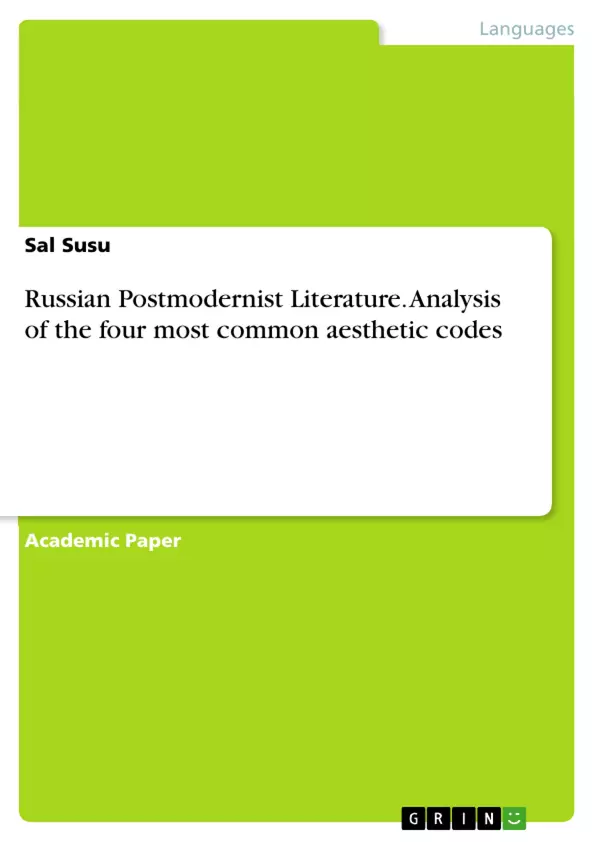This paper focuses exclusively on Postmodernism literature and analyze the 4 most common aesthetic codes. Postmodernism dismissed the central idea of modernist and avant-garde trends, which is the mythologization of existence and reality. These trends tended to create utopian or idealistic paradigms of life that transcended all forms of primitive negativity, such as violence, inhumanity, poverty, and depression.
Postmodernism holds the idea that myths are just mere creations (created by certain people) that have no basis in reality, and that these myths are often used as a form of brainwashing or social coercion, which force the masses to believe in a single form of reality and way of existing.
Postmodernism originally was a critique against Socialist Realism (the Communist myth), and now focuses on questioning and deconstructing all contemporary concepts, such as intelligence, beauty and happiness. However, Postmodernism is by no means an attempt to say that nothing in life is "real", rather, it holds an ambivalent view towards all ideas and points of view, deconstructing them, and then reconstructing them and amalgamating them into one big, playful whole.
Thus, Postmodernism holds that all ideas have potential but refuses to side with any particular idea. It seeks to form a compromise that meets somewhere in the middle between 2 extreme polar ideas, whereas previous modernist trends believed that polar opposites were incompatible.
Inhaltsverzeichnis (Table of Contents)
- Russian Postmodernism
- Postmodernist Literature and its Aesthetic Codes
- Emptiness
- Simulations
Zielsetzung und Themenschwerpunkte (Objectives and Key Themes)
This paper aims to analyze the four most common aesthetic codes in Russian Postmodernist literature. It examines how these codes manifest in selected works and their relation to the broader context of Postmodernism as a response to Modernism.
- Russian Postmodernism as a reaction to Modernism and Socialist Realism
- The aesthetic code of "emptiness" or "garbage" in literature
- The concept of "simulations" and its representation in literature
- Critique of utopian ideals and the representation of mundane reality
- The use of allegory and symbolism in postmodernist novels
Zusammenfassung der Kapitel (Chapter Summaries)
Russian Postmodernism: This section introduces Russian Postmodernism as an artistic trend emerging in the 1960s and 70s, initially operating underground due to its opposition to Soviet ideologies. It contrasts Postmodernism with Modernism, highlighting the former's rejection of utopian ideals and its focus on deconstructing established realities and concepts. The inherent ambiguity of Postmodernism is emphasized, rejecting extreme polar opposites in favor of a compromising middle ground, contrasting sharply with the absolutist nature of Modernist thought. The introduction sets the stage for a deeper dive into the aesthetic codes of Postmodernist literature.
Postmodernist Literature and its Aesthetic Codes: This section delves into two key aesthetic codes prevalent in Postmodernist literature: "emptiness" and "simulations." "Emptiness," exemplified by Victor Pelevin's "Zheltayastrela (The Yellow Arrow)," portrays a seemingly pointless existence within a confined, repetitive environment (a perpetually moving train) as a critique of Modernist utopianism. The characters’ lack of distinct personalities and meaningful relationships underscore the themes of meaninglessness and the cyclical nature of life. "Simulations," as theorized by Jean Baudrillard, posits reality as a human-constructed representation. This concept is explored through Pelevin's "Omon Ra," which allegorically represents the Soviet Union's propaganda and fabricated reality. The chapter also uses Vladimir Nabokov's "Lolita" as another example to demonstrate how reality can be a simulation based on the main character's delusions.
Schlüsselwörter (Keywords)
Russian Postmodernism, Modernism, Socialist Realism, Victor Pelevin, Vladimir Nabokov, "emptiness," "garbage," "simulations," deconstruction, allegory, Soviet propaganda, utopian ideals, mundane reality, repetitive existence.
Frequently Asked Questions: A Comprehensive Language Preview of Russian Postmodernism
What is the focus of this text?
This text provides a comprehensive overview of Russian Postmodernist literature, focusing on its key aesthetic codes and their manifestation in selected works. It analyzes how these codes represent a response to Modernism and Socialist Realism.
What are the main aesthetic codes discussed?
The text primarily examines two key aesthetic codes: "emptiness" (or "garbage") and "simulations." "Emptiness" refers to a sense of meaninglessness and repetitive existence, while "simulations" explores the idea of reality as a constructed representation.
Which authors and works are analyzed?
The analysis includes works by Victor Pelevin (Zheltayastrela (The Yellow Arrow) and Omon Ra) and Vladimir Nabokov (Lolita). These novels serve as case studies to illustrate the discussed aesthetic codes.
How does Russian Postmodernism relate to Modernism and Socialist Realism?
The text positions Russian Postmodernism as a reaction against both Modernism's utopian ideals and Socialist Realism's propagandistic narratives. It highlights Postmodernism's rejection of absolute truths and its embrace of ambiguity and deconstruction.
What are the key themes explored in the text?
Key themes include the critique of utopian ideals, the representation of mundane reality, the use of allegory and symbolism, the concept of repetitive existence, and the manipulation of reality through simulations and propaganda.
What is the overall objective of the paper?
The paper aims to analyze the four most common aesthetic codes in Russian Postmodernist literature, examining how these codes manifest in selected works and their relation to the broader context of Postmodernism as a response to Modernism.
What are the chapter summaries about?
The chapter summaries provide overviews of the introduction to Russian Postmodernism, contrasting it with Modernism; and a detailed exploration of the aesthetic codes of "emptiness" and "simulations" through analyses of specific literary works.
What keywords are associated with this text?
Keywords include: Russian Postmodernism, Modernism, Socialist Realism, Victor Pelevin, Vladimir Nabokov, "emptiness," "garbage," "simulations," deconstruction, allegory, Soviet propaganda, utopian ideals, mundane reality, repetitive existence.
What is the table of contents?
The table of contents includes sections on Russian Postmodernism, Postmodernist Literature and its Aesthetic Codes (with subsections on Emptiness and Simulations), Objectives and Key Themes, Chapter Summaries, and Keywords.
- Quote paper
- Sal Susu (Author), 2021, Russian Postmodernist Literature. Analysis of the four most common aesthetic codes, Munich, GRIN Verlag, https://www.grin.com/document/1027366



